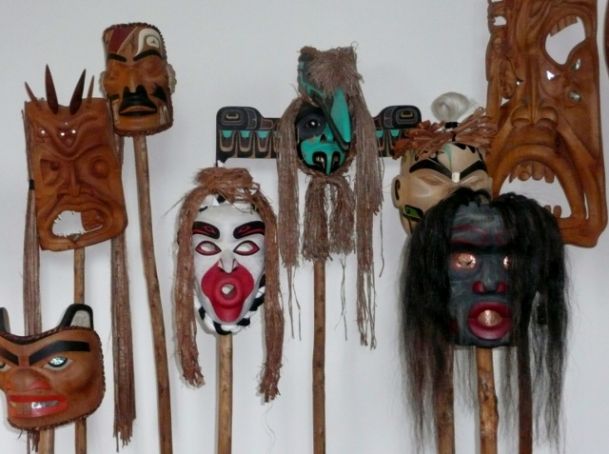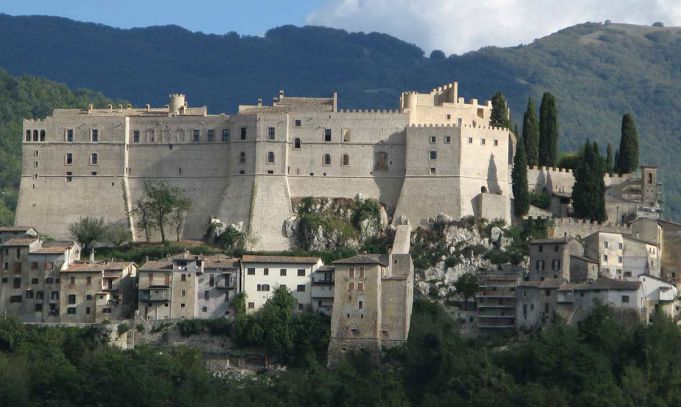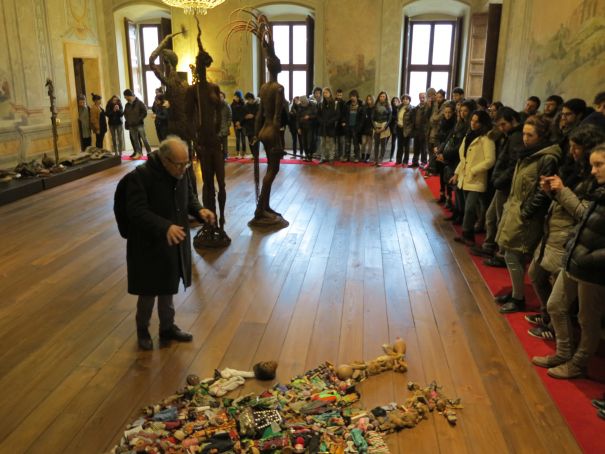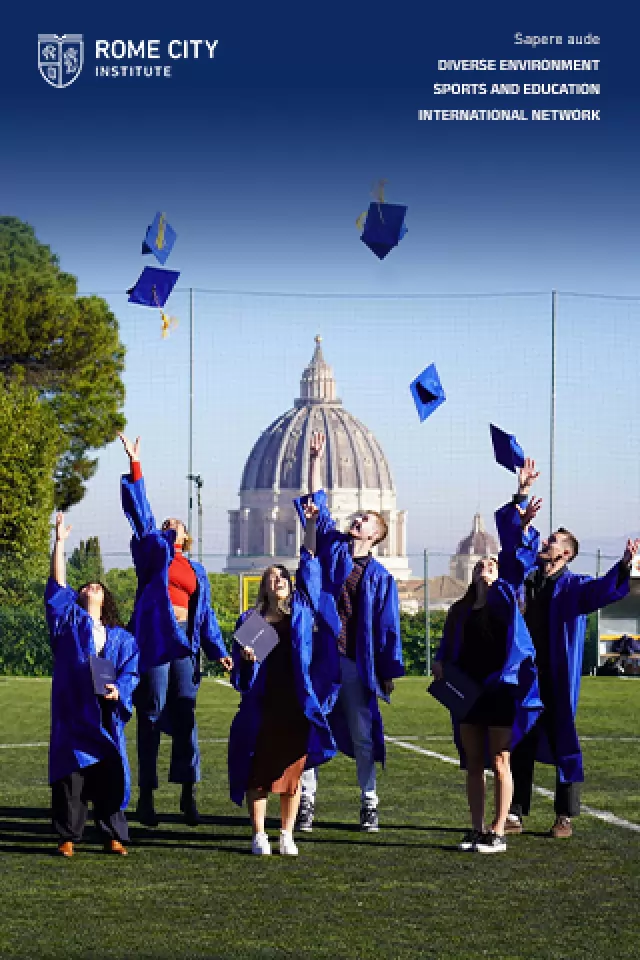The strange, multi-layered story of Rocca Sinibalda, located 50 km north of Rome.
The 12th-century Rocca Sinibalda sits on a spur of rock dominating the Turano Valley, a 40-minute drive north of Rome, on what was once a vital trade route between the Medici territories and the papal states. Looking across the valley from the opposite side, the Castle of the Eagle, as it is called, makes a romantic picture – a typical mediaeval fortress, with massive bastion walls topped with battlements and lookout turrets.
However, there is nothing typical about Rocca Sinibalda, a fortress-cum-palace with several names, a bizarre architectural form, a quirky history and a unique and disquieting art collection. As well as the Castle of the Eagle, it is also called the Castle of Metamorphoses, while the plaque by the entry door refers to it as the Castle of Invented Destinies. Each of these names refers to a crucial phase in the fortress's chequered history.
Castle of the Eagle, its most usual name, refers to its eccentric shape. According to records, it was first built in the 11th century as a classic Norman stronghold by Count Sinibaldo, the governor of the Sabina area, and survived the following couple of centuries of bloody clashes among local warring barons.
Eagles and scorpions
In 1539, the Medici Pope Leone X handed the castle over to his great friend Cardinal Alessandro Cesarini. Cesarini was a man of refined tastes, who liked his comforts, who commissioned Baldassarre Peruzzi, one of the architects working on St Peter's, to transform the interior into a noble residence. Peruzzi's expansions included the two “eagle wing” bastions jutting out at the rear and the pointed “bird beak” (or “scorpion”, according to some) at the front, overlooking the hamlet below. Thanks to its novel architectural design, Rocca Sinibalda was declared a national monument in 1928.
The building takes its second name, the Castle of Metamorphoses, from the decorations in the reception rooms of the piano nobile, a 16th-century riot of grotesques and legendary hybrid creatures inspired by Ovid's fanciful tales of myth and transformation.
The true focus of the castle, however, is its art collection, combining an intriguing mix of classic landscape painting, contemporary installations and the ritual masks of Native American peoples of the Pacific coast of the USA and Canada.
Realm of the Mothers
The 18th-century frescoes and landscapes in the great hall are eclipsed by the sculpture group of the Realm of the Mothers by the Italo-Argentinean artist Marcos Cei, which dominates the centre of the room. The three dark, scrawny mothers, personified by a winged Angela, a flame-spouting Vulcania, and a one-breasted warrior Amazonia are figures of terror, composed of scrap iron, chains, bolts, wire and discarded machine parts.
Stretched out prostrate on the floor near them are a couple of life-sized human figures made up of collages of assorted pieces, representing the suffering of immigrants. These are an introduction of what lies downstairs, in the "Inferi", or nightmare underworld, seat of the permanent StraVOLTI exhibition, inaugurated in 2014.
Two grimacing devils crouch inside the entrance to a series of dark, cellar-like rooms filled with gloomy tableaux and macabre installations portraying the more tragic aspects of the human condition, set up by Vincenzo Padiglione, a professor of psychology at La Sapienza University of Rome, and anthropologist, collector and ethnographic museum curator.
Totems and ritual masks
The next set of rooms is dedicated to Rocca Sinibalda's important collection of totems and ritual masks from endangered ethnic minority groups of the north-west Pacific coast of North America. Many of these works are by well-known Canadian and Inuit artists such as Art Thomson, Beau Dick, Ron Telek and Tom Hunt, members of the First Nations Community of peoples who inhabited the American continent before the arrival of the Europeans.

The castle has a vast collection of ritual masks and First Nation art which reflect the distinctive styles and traditions of each single people. Over 500 exotic and contemporary masks in the collection belong to Padiglione.
Since 1972, the castle has been in the hands of a foundation, headed by psychoanalyst and business consultant Enrico Pozzi and his anthropologist wife Cristina Cenci. When they took over the old stronghold-palace, it had been abandoned for many years after the previous owner, the eccentric American millionairess Polly Crosby (better known by her adopted first name "Caresse") moved out.
The castle had fallen into disrepair and the new owners entrusted architect Claudio Silvestrin with the job of conversion and reconstruction. The difficult restoration took seven years, and won the prestigious Chicago Athenaeum International Architectural Award in 2014.

Tangible traces of Crosby's dynamic and unconventional personality remain. The main entrance through the courtyard, under the "eagle's beak", leads onto a long shallow pool open to the sky. This was where the guests of the former owner sat with their feet in the water while they meditated, composed poetry and philosophised. Inside, a long underground gallery leads to a small amphitheatre backing on to the mediaeval water storage cistern.
This was where Crosby's guests staged experimental performances of theatre, poetry and dance. The string of visitors included Ezra Pound, Salvador Dalì, Allen Ginsberg, Robert Snyder and The Living Theatre founders, Julian Beck and Judith Malina, along with many others, including Crosby's bosom chum and sister socialite Peggy Guggenheim.
The “Black Sun Press”, the publishing house that she founded with her third husband Harry Crosby, printed beautiful editions of hand-crafted books, as well as the early works of Ernest Hemingway, Henry Miller, Archibald MacLeish, Anaïs Nin, Charles Bukowski, D.H. Lawrence, Laurence Stern, James Joyce and other controversial early 20th-century writers.
Lost Generation
After she divorced her first husband, she moved to Europe and became part of the "Lost Generation" of American ex-patriots who lived it up in Paris with wild parties, drugs and open marriages. She changed her name to the more exotic-sounding “Caresse” in 1924 when she married Crosby. Unfortunately this marriage was no more fortunate than her previous ones. Harry Crosby was fascinated with death and symbolism and he committed suicide in 1929 along with his young "Fire Princess", Josephine Noyes Rotch.
Crosby was not long in finding consolation. Her many lovers included photographer Henri Cartier-Bresson, (whose camera is on display in the great hall). He was so broken-hearted by their break-up that he took off in self-imposed exile to the French colonial Ivory Coast to recover. Crosby went on regardless, creating scandal after scandal.
Crosby moved to her Rome residence in 1970 and put the castle up for sale shortly before she died at 78 of pneumonia, but her legacy lingers on. Its tradition as a centre of experimental art continues with seminars and residential programmes for international artists. And this is where the third name – the Castle of Invented Destinies – comes in, with a biennial festival of the arts, organised and created in house by groups of young international artists of various disciplines who come for short study stays at the castle.

The first edition in 2014 attracted sold-out audiences for its version of Richard III. The theme of "The Hanged Man" in the second edition, centred on the most mysterious card in the tarot pack, was inspired by Italo Calvino's enigmatic book The Castle of Crossed Destinies. True to type, the 2018 festival in July explored another disquieting subject, centring on the Black Death. The performance Endecameron was inspired this time by Edgar Allen Poe's horror story The Masque of the Red Death.
By Margaret Stenhouse
Guided tours of the castle for individual visitors are *usually available (pre covid-19 pandemic) on Saturdays at 16.00 and Sundays at 11.00. Prior booking is necessary. Visits at other times can be arranged for groups of at least 15 people. For info tel. 0644233634, info@castelloroccasinibalda.it, www.castellodestininventati.it.
This article was published in the October 2018 edition of Wanted in Rome magazine. Cover photo: Buffy1982 / Shutterstock.com.
General Info
View on Map
Rocca Sinibalda: Lazio's most mysterious castle
02026 Rocca Sinibalda RI, Italia


















